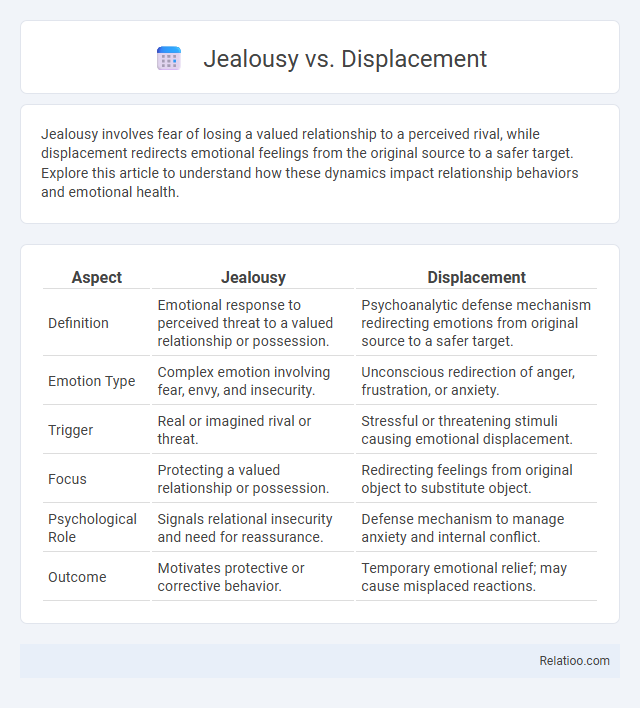Jealousy involves fear of losing a valued relationship to a perceived rival, while displacement redirects emotional feelings from the original source to a safer target. Explore this article to understand how these dynamics impact relationship behaviors and emotional health.
Table of Comparison
| Aspect | Jealousy | Displacement |
|---|---|---|
| Definition | Emotional response to perceived threat to a valued relationship or possession. | Psychoanalytic defense mechanism redirecting emotions from original source to a safer target. |
| Emotion Type | Complex emotion involving fear, envy, and insecurity. | Unconscious redirection of anger, frustration, or anxiety. |
| Trigger | Real or imagined rival or threat. | Stressful or threatening stimuli causing emotional displacement. |
| Focus | Protecting a valued relationship or possession. | Redirecting feelings from original object to substitute object. |
| Psychological Role | Signals relational insecurity and need for reassurance. | Defense mechanism to manage anxiety and internal conflict. |
| Outcome | Motivates protective or corrective behavior. | Temporary emotional relief; may cause misplaced reactions. |
Understanding Jealousy: Definition and Core Concepts
Jealousy is an emotional response triggered by the perceived threat to a valued relationship or possession, often involving fear of loss and insecurity. Unlike displacement, which involves shifting emotions from their original source to a safer target, jealousy directly centers on fears of rivalry and attachment. Understanding your jealousy requires recognizing its root in vulnerability and the desire for security in personal connections.
What is Displacement in Psychology?
Displacement in psychology refers to the unconscious defense mechanism where an individual redirects emotions or impulses from a threatening target to a safer substitute, often to reduce anxiety or conflict. Unlike jealousy, which involves feelings of envy toward someone else's advantages or relationships, displacement shifts emotional reactions away from the original source of stress to less threatening objects or people. Your understanding of displacement helps identify how certain behaviors might be coping strategies rather than direct responses to specific situations.
Key Differences Between Jealousy and Displacement
Jealousy is an emotional response arising from fear of losing something valuable, often involving interpersonal relationships, whereas displacement is a defense mechanism where emotions are redirected from a threatening object to a safer target. Jealousy typically involves complex social dynamics and possessiveness, while displacement functions unconsciously to manage anxiety or unacceptable feelings by shifting them onto unrelated subjects. Understanding these key differences clarifies that jealousy is an affective state linked to personal insecurity, whereas displacement is a psychological process used to cope with internal conflict.
Common Triggers of Jealousy
Common triggers of jealousy include perceived threats to your relationships, fear of losing a loved one, and comparison with others' achievements or qualities. Displacement occurs when emotions like anger or frustration are redirected from their original source to a safer target, often unrelated to the initial cause. Understanding these emotional responses helps you recognize how jealousy differs from displacement, both rooted in managing complex feelings but triggered by distinct psychological processes.
How Displacement Manifests in Everyday Life
Displacement manifests in everyday life when individuals redirect emotions or reactions from a threatening object to a safer substitute, such as expressing anger at a coworker instead of the source of frustration. This psychological defense mechanism is distinct from jealousy, which involves feelings of envy and insecurity over perceived threats to a relationship. Understanding how displacement operates can help you recognize and manage misplaced emotions, improving personal interactions and emotional well-being.
Emotional Impact: Jealousy vs Displacement
Jealousy triggers intense emotional distress linked to fear of loss and perceived threats to relationships, often leading to anxiety, insecurity, and resentment. Displacement channels emotions away from the original source toward a safer target, temporarily reducing direct conflict but potentially causing misplaced anger or frustration. The emotional impact of jealousy tends to be more personal and relational, while displacement serves as a defense mechanism diffusing emotional tension indirectly.
Psychological Mechanisms Behind Jealousy
Jealousy involves complex psychological mechanisms including fear of loss, insecurity, and perceived threats to self-esteem, often triggering emotional responses like anxiety and anger. Displacement, a defense mechanism, redirects feelings from an original source of frustration to a safer substitute target, helping manage difficult emotions indirectly. Unlike jealousy, which centers on relational threats, displacement operates more broadly to alleviate internal conflict by shifting emotional energy away from the true source of distress.
The Role of Displacement in Coping with Difficult Emotions
Displacement plays a crucial role in helping you cope with difficult emotions by redirecting feelings from a threatening target to a safer outlet, allowing temporary relief from stress or anxiety. Unlike jealousy, which involves resentment or envy toward someone else's success or possessions, displacement shifts emotions away from their original source to avoid direct confrontation. This defense mechanism enables emotional processing while preventing potential harm in relationships or situations that provoke intense feelings.
Strategies to Manage Jealousy and Displacement
Effective strategies to manage jealousy involve recognizing and addressing underlying insecurities through emotional self-awareness and open communication. Displacement, often a defense mechanism redirecting emotions to safer targets, can be managed by identifying triggers and practicing mindfulness to respond rather than react impulsively. Combining cognitive-behavioral techniques with stress reduction methods enhances emotional regulation, reducing the impact of both jealousy and displacement on mental well-being.
When to Seek Help: Addressing Unhealthy Patterns
Unhealthy jealousy often manifests as irrational suspicion and controlling behavior, signaling the need for intervention when it disrupts relationships or causes emotional distress. Displacement becomes problematic when individuals consistently redirect negative emotions towards innocuous targets, impairing personal or social functioning. Seeking professional help is crucial if these patterns persist, leading to anxiety, depression, or significant interpersonal conflict.

Infographic: Jealousy vs Displacement
 relatioo.com
relatioo.com